This chicken, shrimp, and sausage jambalaya takes a little prep work to make, but SO worth it - great flavours & textures, very satisfying!
Originally published October 19, 2009. Updated on 2/13/2023
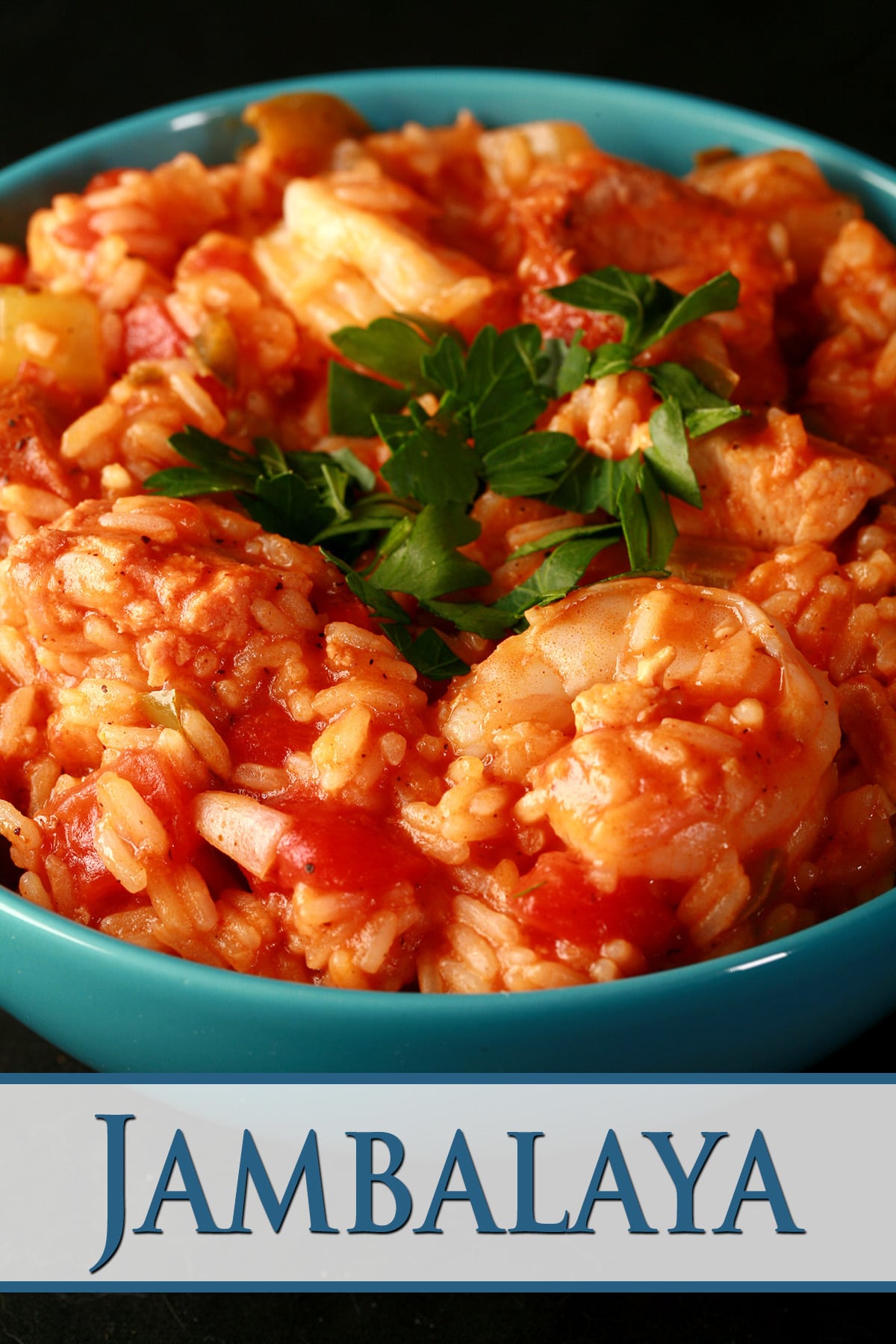
A Note from The Future: This blog entry was written in 2009, almost 2 years before it played a big role in our tornado recovery experience. To read about that, click here!
I LOVE jambalaya - it’s pretty much the perfect one-pot dish!
Actually, ever since a trip to New Orleans back in 2005, I have a particular affection for most Cajun and Creole food in general. It's always full of flavor, and very, VERY satisfying!
As far as jambalaya goes, we’re talking about a dish that’s easy to make, hearty dish, and has SO much flavor - courtesy of infused cooking liquid, the Maillard reaction, and a bunch of Cajun spices.
It is also a versatile dish in general, and can be a good way to use up bits of ingredients.
I like making a huge batch of this on a weekend, then pretty much living on it for a week or so - it makes GREAT leftovers!
It freezes fairly well, but never lasts long enough to make it to the freezer.
It’s also not bad in terms of dirtying dishes - you’ll need a pot, cutting board, knife, and some measuring implements.
As far as cleanup goes, it’s a GREAT payoff for the amount of dishes to clean!
As I said - the perfect one-pot meal!
What is Jambalaya?
Jambalaya is a hearty rice dish from Louisiana, and definitely the product of a mixing of cultures there.
Some theories on the name say that it’s a mix of “Jambon” - French for “ham” and “Aya”, which is an African word for “rice”.
Others claim that is came from Spanish settlers in the area, pointing to paella as a possible source material.
As jambalaya is similar to both Jollof Rice - an African dish - and Spanish Paella, it’s definitely easy to see potential for both African and Spanish influences on the dish.
Anyway...
There are a couple main different ways to make jambalaya: The Creole version, and the Cajun version: The main difference comes down to the use of tomatoes.
Creole jambalaya is considered “red jambalaya”, as it uses tomatoes as part of the cooking liquid.
On the other hand, Cajun jambalaya is sometimes referred to as “brown jambalaya”, as it does not use tomatoes.
This recipe is for a creole style jambalaya - I haven’t actually tried the Cajun dish! I should probably change that, sometime soon!
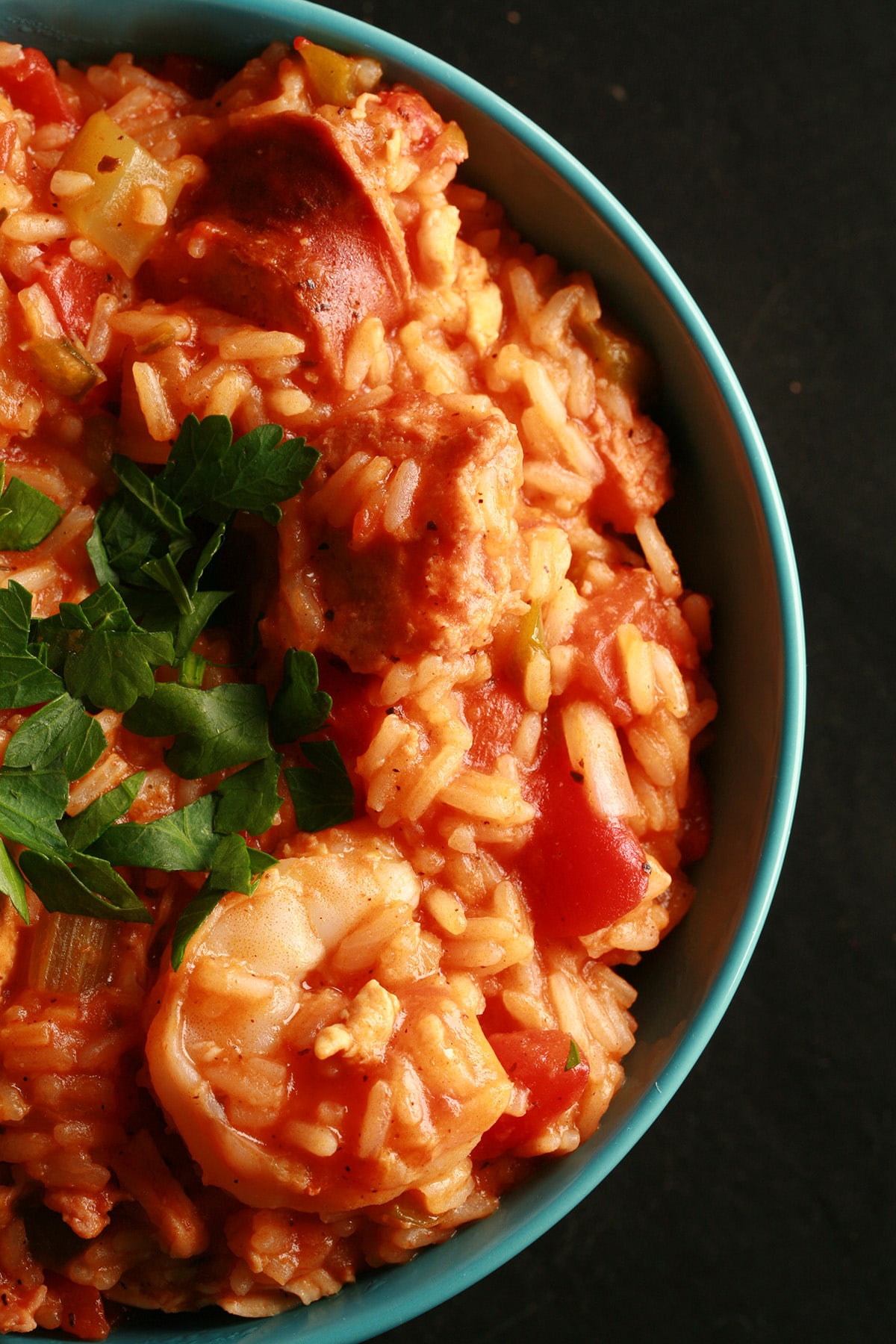
Jambalaya Ingredients
This recipe has a long list of ingredients, but they’re all basically simple ingredients that can be found in any grocery store.
I tend to look at them as a few different groups of main ingredient categories:
The Liquids / Broth Base
As a rice dish, you’ll need a flavorful liquid to reconstitute and cook the rice in.
I start out with a basic chicken broth - you can buy boxed chicken stock, or use homemade chicken stock - which I flavour with the shells left over from the shrimp that gets used, as well as some extra veggies.
More on that in a bit, though.
While some jambalaya recipes use tomato sauce or tomato juice, I like to get the tomato in the form of both diced tomatoes and tomato paste.
Between infusing the broth and using the tomatoes this way, this gives a HUGE flavour boost to the final jambalaya.
The Meats
This recipe uses 3 different meats: sausage, chicken, and shrimp.
If you can get some spicy Andouille sausage, that’s the best - and most traditional - sausage to use for this.
Between Minnesota and Hamilton, I’ve found it hard to come by at times, and end up using a Kiebassa style smoked pork sausage, when needed.
As for the chicken, I like to use boneless skinless chicken breasts, but you can use boneless skinless chicken thighs if you prefer.
As far as the shrimp goes, you’re going to need uncooked shrimp. Already cooked shrimp runs the risk of overcooking, in this recipe.
I like to use large shrimp or jumbo shrimp, but feel free to use whatever availability or budget allows for.

The Vegetables
As with many dishes in Cajun and creole cooking, this recipe starts out with the “holy trinity”: green peppers , yellow onion, and celery.
In addition to the green bell pepper, I use a red bell pepper and some chopped jalapeno pepper, for a bit more flavor.
The Rice
This recipe needs you to start with uncooked rice. White rice is traditional - I usually like to use long grain rice for this, as it looks better... but short-grain works also... it just doesn't look as nice!
Alternatively, you can swap in brown rice if you prefer.
Just keep an eye on things - you may need to add a bit more liquid, or let it cook a bit longer.
You want the rice to be fully cooked BEFORE adding the shrimp.

The Herbs and Spices
While a lot of jambalaya recipes I’ve seen feature a premix Creole seasoning or Cajun seasoning as the main spice, I like to use individual spices.
I’ve always preferred having that level of control over the final flavor of a dish. For my recipe, you’ll beed:
Fresh garlic cloves (You can use 2-3 teaspoon of garlic powder if you prefer.)
Bay Leaves
Cayenne Pepper
Ground Black Pepper
Dried Oregano
Dried Sage
Dried Thyme
Salt
If you’d like some extra heat after all is said and done, feel free to add some Red Pepper Flakes or Chili Powder, to taste.
Note: This jambalaya recipe works best if you do some pre-work before really getting started. I like to measure my spices out in a little bowl, and chop all the vegetables, before starting anything.

How to Make Jambalaya
Full recipe follows at the end of this post, but here is a pictorial overview, for those who like to see how it comes together!
Flavour the Stock (Optional)
Start out by flavoring your chicken stock. This is optional, but very much worth the effort!
Peel all 2 lbs of your shrimp, putting shells and tails in a medium or large pot or large Dutch oven (not the LARGE pot you’ll need to make the jambalaya though!).

Cover shrimp shells with the 8 cups broth.
Note: I’ll usually add a cup or so of extra liquid, as you can lose some volume in the simmering process.
Lost broth volume could also be made up with a bit more straight broth, or a little water.
Optionally, feel free to add any celery you have left after reserving 4-6 ribs, some onion, or whatever else you’d like to flavor the stock with.

Simmer stock on low heat for 30 minutes to an hour or so, until it smells and tastes amazing.
Use a slotted spoon to remove the large pieces of onion / celery. Strain the rest of the solids out, and reserve the stock.
Note: If you have more time, you can simmer the broth in a slow cooker for a few hours, rather than simmer on the stove.
Make the Jambalaya
In the meantime, chop all of your vegetables.
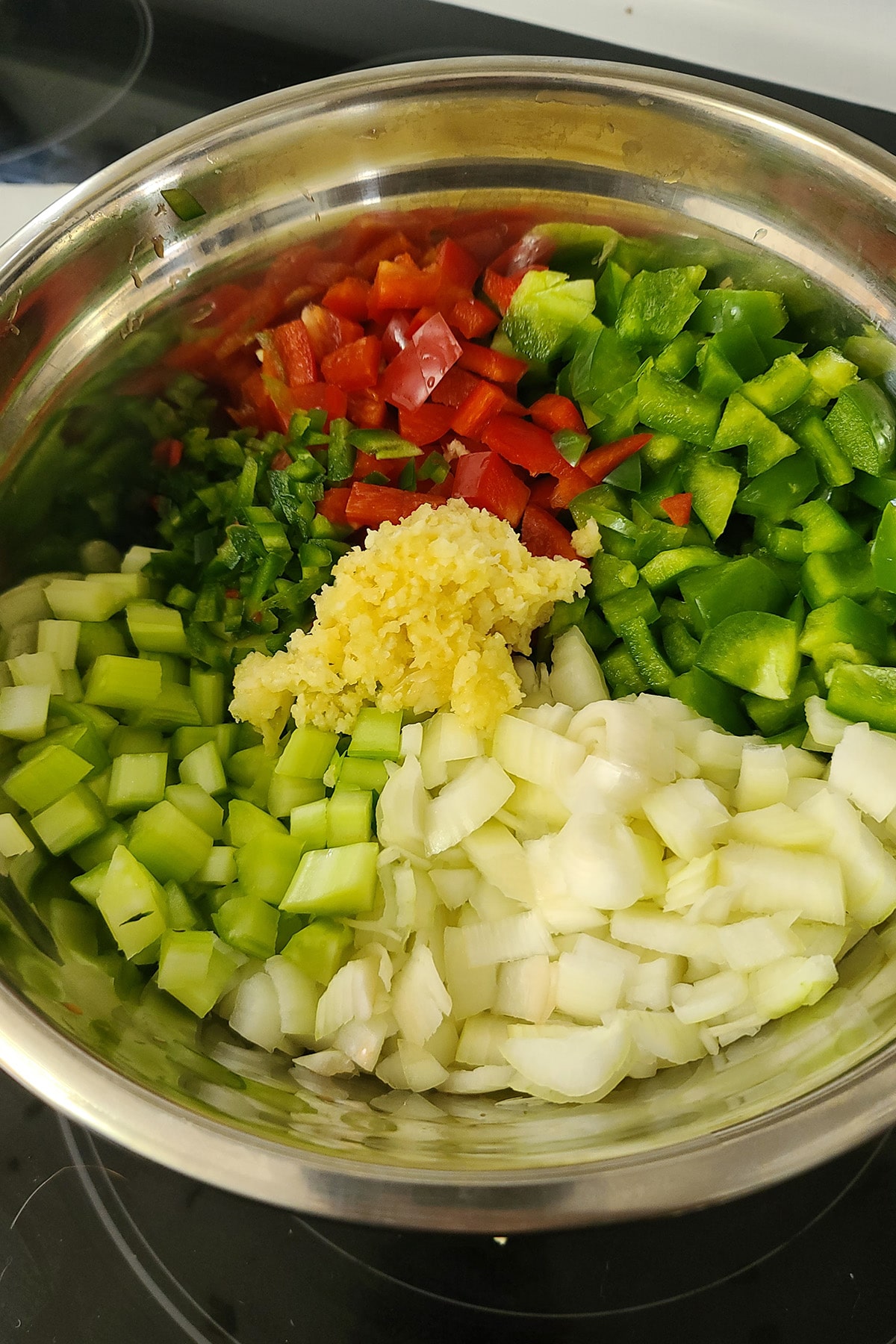
In LARGE (1.5 gallon!), heavy pot: brown chicken and sausage in a little olive oil over medium-high heat.

Add onions, peppers, and sausage. Cook vegetables until soft.

Add tomato paste to vegetables. Cook, stirring frequently, until tomato paste starts to caramelize/ brown a bit.
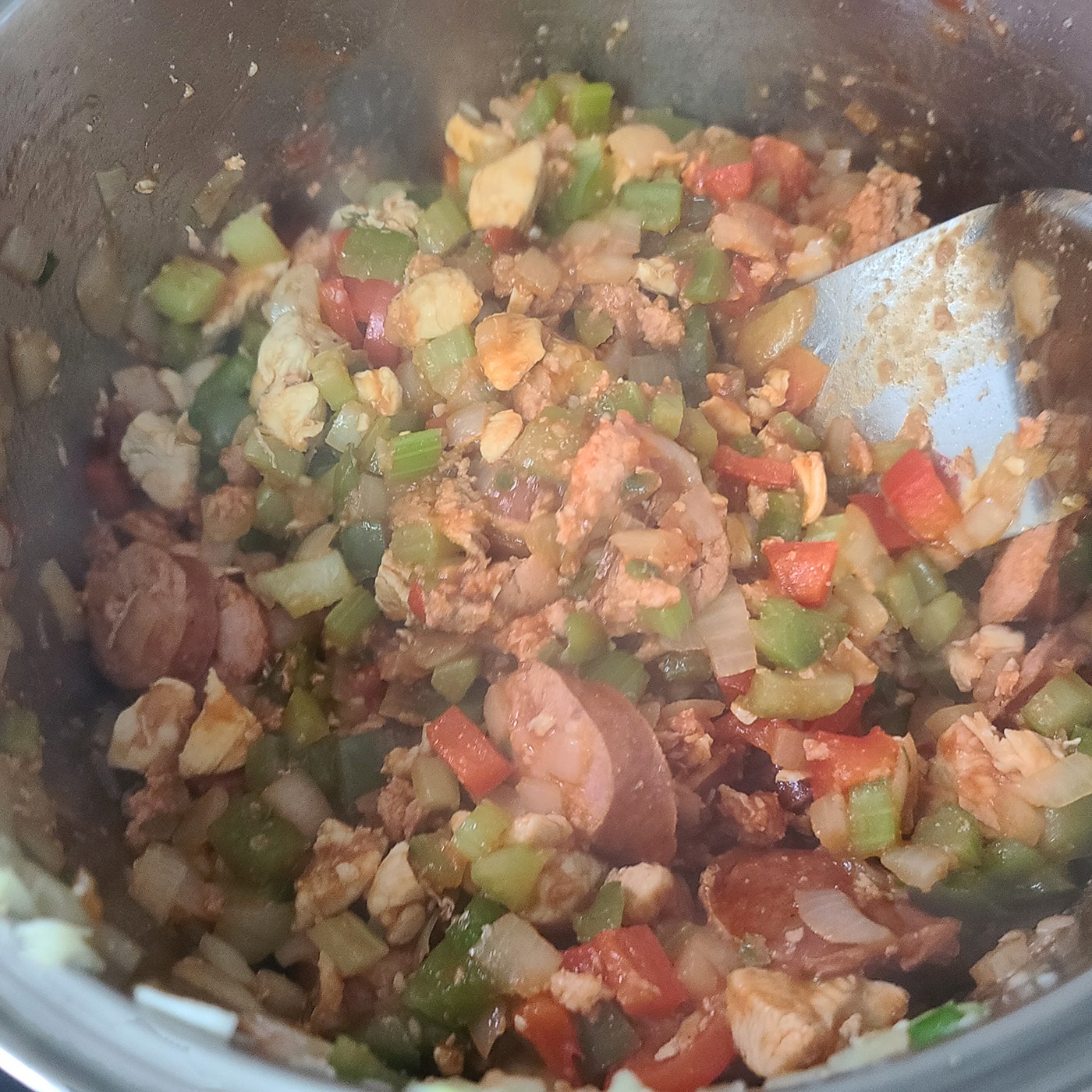
Add diced tomatoes, cooked chicken breast, shrimp stock, and all of the herbs and spices – everything remaining, aside from the rice & raw shrimp.
Be sure to scrape the bottom of the pan, incorporating the browned bits into the liquid.

Add rice to pot.
Cover and cook on low for 20 minutes or so, stirring fairly frequently – you don’t want it to burn onto the bottom of the pot!

When rice is almost cooked through, add shrimp to pot and stir well.

Remove and discard the bay leaves.
Serve hot, with hot sauce - if desired!
I like to garnish my jambalaya with chopped fresh parsley, and/or sliced green onions.
Leftovers
Once cooled to almost room temperature, leftovers can be stored in an airtight container in the fridge for 3-5 days or so.
To reheat the next day, stir in any excess water that may have pooled (if not cooled before storing).
Cover and heat in the microwave, stirring often, until it’s as hot as you like it.
Note: This jambalaya is just as good the next day, as it is fresh!
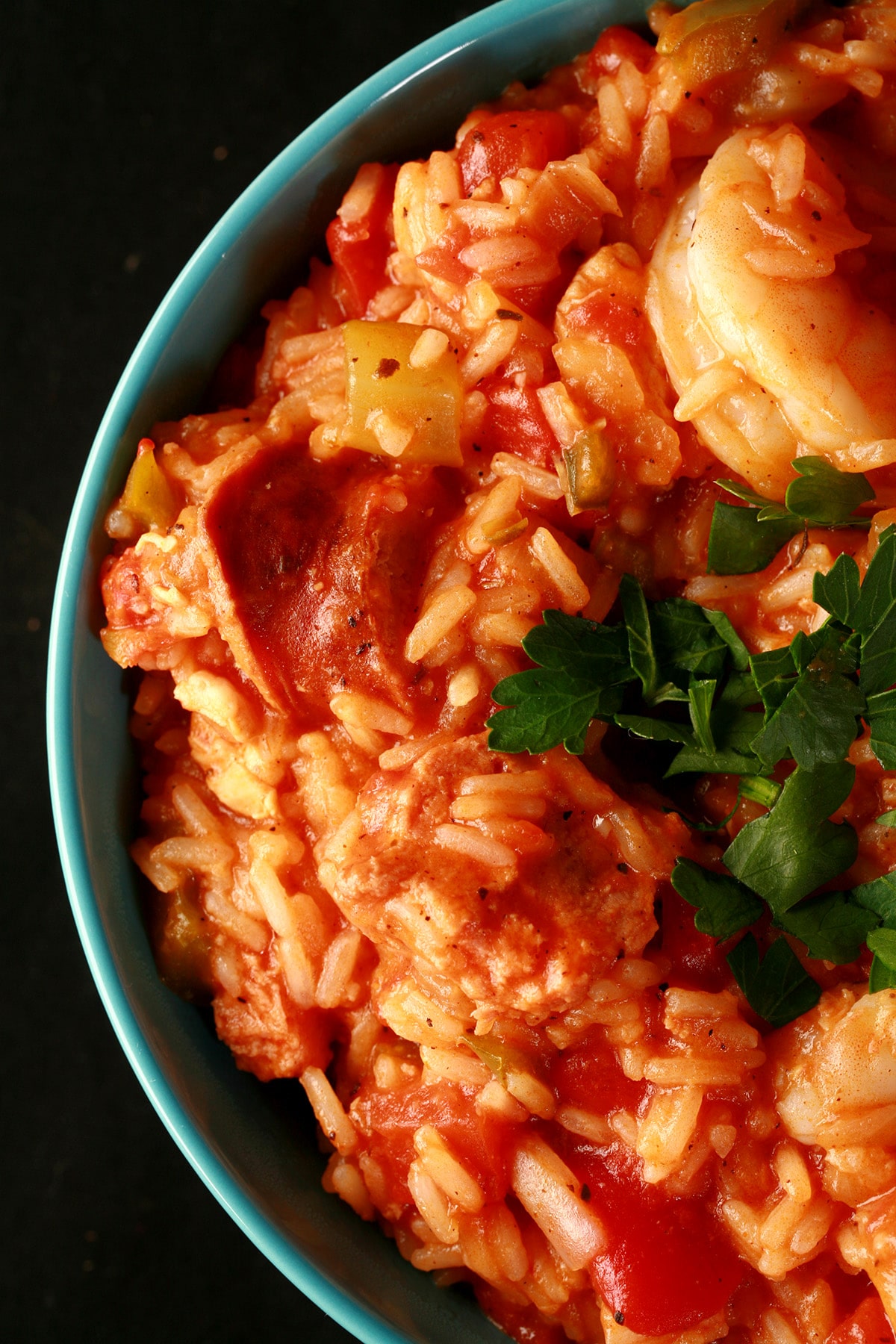
More Soup, Stew, Etc Recipes
Looking for a bowl of some warm comfort food for a cool day? Check these out...
Convention Chili
Corn Chowder
Creamy Chicken Wild Rice Soup (Gluten-Free)
Fennel Chicken & Sausage Soup
French Canadian Pea Soup
Hearty Beef Stew
Hearty Corn & Black Bean Soup
Keto Beef Stew
Keto Clam Chowder
Roasted Cauliflower Soup
Smoky Campfire Chili
Roasted Chili Verde

Share the Love!
Before you chow down, be sure to take some pics of your handiwork! If you post it to Bluesky, be sure to tag us - @CelebrationGen. We're also on Pinterest, so you can save all your favourite recipes to a board!
Also, be sure to subscribe to my free monthly email newsletter, so you never miss out on any of my nonsense. Well, the published nonsense, anyway!
Finally, if you love this recipe, please consider leaving a star rating and/or a comment below, and maybe even sharing this post on social media!

Chicken, Shrimp, and Sausage Jambalaya Recipe {Creole Style]
Ingredients
- 2 lbs Large Raw Shrimp Deveined, shell still on
- 8 cups Chicken Stock
- 2 lbs Boneless Skinless Chicken Breast cubed
- 2 tablespoon Vegetable Oil
- 2 lbs Andouille Sausage Substitute kielbassa if unavailable
- 2 Large Onions chopped
- 2 Green Bell Peppers chopped
- 1 Red Bell Peppers chopped
- 1 Jalapeno Pepper chopped
- 4-6 Celery Ribs chopped
- 1 Small Can Tomato Paste
- 2 28 oz cans Diced Tomatoes
- 6-8 Garlic Cloves pressed
- 3 teaspoon Cayenne
- 2 teaspoon Ground Black Pepper
- 1 teaspoon Dried Oregano
- 1 teaspoon Dried Sage
- 1 teaspoon Dried Thyme
- 2 Bay Leaves
- 1 teaspoon Salt
- 2 lb White Rice
Instructions
- Start out by flavoring your chicken stock. This is optional, but very much worth the effort!
- Peel all 2 lbs of your shrimp, putting shells and tails in a medium or large pot (not the LARGE pot you’ll need to make the jambalaya though!). Cover raw shrimp and keep it in the fridge for later. Cover shrimp shells with the chicken stock.
- Optionally, feel free to add any celery you have left after reserving 4-6 ribs, some onion, or whatever else you’d like to flavor the stock with. I like just celery and onion in mine, leaving additional flavors for later! Heat stock on low for 30 minutes to an hour or so, until it smells and tastes amazing. Strain everything out, and reserve the stock.
- In the meantime, brown chicken in vegetable oil, set aside.
- In LARGE, heavy pot: brown sausage. Add onions, peppers, and sausage. Cook vegetables until soft.
- Add tomato paste to vegetables. Cook, stirring frequently, until tomato paste starts to caramelize/ brown a bit. This will add a lot of flavor to the finished jambalaya. Keep a close eye on it, do NOT allow it to burn!
- Add diced tomatoes, cooked chicken breast, shrimp stock, and all of the herbs and spices – everything remaining, aside from the rice & raw shrimp. Turn heat down to low, and simmer for 10-20 minutes. Taste, and adjust seasonings if desired.
- Add rice to pot. Cover and cook on low for 20 minutes or so, stirring fairly frequently – you don’t want it to burn onto the bottom of the pot! Remove lid, allow to cook uncovered for another 5- 10 minutes or so, depending on your rice. When rice is almost cooked through, add shrimp to pot and stir well. Cook until rice is done, and shrimp is cooked through.
- Remove and discard the bay leaves.Serve hot!
Notes
- I usually like to use long grain rice for this, as it looks better... but short grain works also. I didn't have any long grain on hand, the day we photographed the recipe 🙂








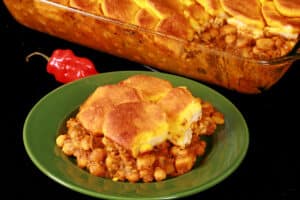
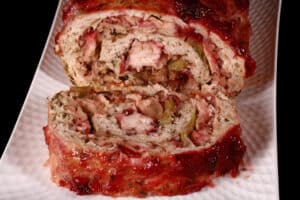

jeanne
This looks great and plan on making this weekend. Just wanted to check - 2 pounds of rice is the same as 5 cups?
Marie Porter
Looks like it - I generally just buy it in 1 lb bags and use 2.
Barbara Heenan Andersen
I remember this dish so very well from when we served it in the parking lot after the tornado when so many in your neighborhood had no electricity and had lost much more to the tornado. I was tasked with serving it to the people and they loved it. Some of them were natives of Louisiana and commented how it tasted like home. I’m glad you have all the tips along the way to ensure success the first time on the crowd pleaser.